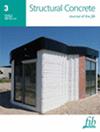Experimental study on the reinforced concrete beams with varied stirrup reinforcement ratio under static and impact loads
IF 3
3区 工程技术
Q2 CONSTRUCTION & BUILDING TECHNOLOGY
引用次数: 0
Abstract
With the increasing utilization of reinforced concrete (RC) beams in eco‐friendly and fast‐paced construction practices, evaluating their impact performance becomes imperative. These beams are susceptible to unforeseen impact loads resulting from accidents or terrorist incidents throughout their service lifespan. Five groups of RC beams, each subjected to different curing periods, stirrup reinforcement, and drop hammer heights, were fabricated. Among these groups, one underwent static load testing, while the remaining groups were subjected to impact load testing utilizing the drop hammer test system. The failure modes, static response, dynamic response, and energy dissipation of RC beams were analyzed. Static tests revealed that RC beams exhibited a flexure‐governed failure mode with top surface concrete crushing, aligning with expectations. With increased stirrup reinforcement ratios, shear and flexural‐shear cracks during impact tests decreased, with high impact loads causing diagonal shear failure, severe concrete crushing, additional diagonal shear cracks, and a broader crack distribution. Higher drop hammer heights were found to increase overall energy dissipation, whereas increased stirrup reinforcement ratios resulted in moderate decrease. Specifically, the overall energy dissipation increased with higher drop hammer heights. Conversely, an increase in the stirrup reinforcement ratio was linked to a certain degree of decrease in overall energy dissipation.静荷载和冲击荷载作用下不同箍筋配筋率钢筋混凝土梁的试验研究
随着钢筋混凝土(RC)梁在环保和快节奏建筑实践中的应用越来越多,对其抗冲击性能进行评估变得势在必行。这些梁在其使用期限内很容易受到意外事故或恐怖事件造成的不可预见的冲击荷载的影响。我们制作了五组不同固化期、箍筋加固和落锤高度的 RC 梁。其中一组进行了静载荷测试,其余各组利用落锤测试系统进行了冲击载荷测试。对 RC 梁的破坏模式、静态响应、动态响应和能量耗散进行了分析。静态测试表明,RC 梁表现出由弯曲控制的破坏模式,顶面混凝土破碎,与预期一致。随着箍筋配筋率的增加,冲击试验中的剪切裂缝和挠剪裂缝减少,高冲击荷载导致斜剪破坏、严重的混凝土破碎、额外的斜剪裂缝和更广泛的裂缝分布。研究发现,落锤高度越高,整体能量耗散越大,而箍筋配筋率越高,能量耗散也会适度降低。具体来说,落锤高度越高,整体耗能越大。相反,箍筋配筋率的增加会在一定程度上降低整体能量耗散。
本文章由计算机程序翻译,如有差异,请以英文原文为准。
求助全文
约1分钟内获得全文
求助全文
来源期刊

Structural Concrete
CONSTRUCTION & BUILDING TECHNOLOGY-ENGINEERING, CIVIL
CiteScore
5.60
自引率
15.60%
发文量
284
审稿时长
3 months
期刊介绍:
Structural Concrete, the official journal of the fib, provides conceptual and procedural guidance in the field of concrete construction, and features peer-reviewed papers, keynote research and industry news covering all aspects of the design, construction, performance in service and demolition of concrete structures.
Main topics:
design, construction, performance in service, conservation (assessment, maintenance, strengthening) and demolition of concrete structures
research about the behaviour of concrete structures
development of design methods
fib Model Code
sustainability of concrete structures.
 求助内容:
求助内容: 应助结果提醒方式:
应助结果提醒方式:


